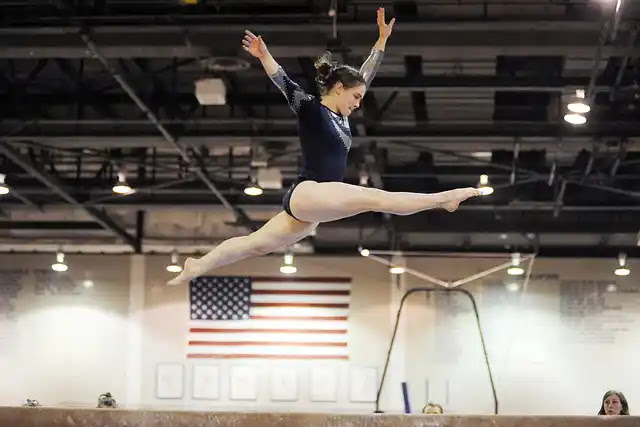Facts about Gymnastics: If you're a fan of gymnastics, or just curious about the sport, there are many fascinating facts to discover. From the history of gymnastics to the various events and equipment, to the intricate scoring system and governing body, there's a lot to explore. Whether you're an athlete, coach, or simply a fan, learning more about the sport can deepen your appreciation for the incredible athleticism and dedication required to excel in gymnastics. In this article, we'll explore a wide range of facts about gymnastics, from the basic rules and equipment to the more complex aspects of the sport.
100 Facts About Gymnastics: The Rules, Scoring System, and FIG
- Gymnastics is a sport that involves a combination of strength, flexibility, balance, and agility.
- The word "gymnastics" comes from the Greek word "gymnazein," which means "to exercise naked."
- The first gymnastics competition was held in 1896 at the Olympic Games in Athens, Greece.
- The modern Olympic Games have included gymnastics events since 1896.
- Women's artistic gymnastics (WAG) and men's artistic gymnastics (MAG) are the two main disciplines of gymnastics.
- WAG consists of four apparatuses: vault, uneven bars, balance beam, and floor exercise.
- MAG consists of six apparatuses: floor exercise, pommel horse, still rings, vault, parallel bars, and horizontal bar.
- Gymnastics is one of the most popular Olympic sports.
- Gymnastics is known for its high degree of difficulty and risk.
- The balance beam is only 10 centimeters wide and four feet off the ground.
- The vault is the most explosive of all the gymnastics events.
- The uneven bars require a combination of strength and grace.
- The floor exercise is the only gymnastics event where athletes can display their personalities through their choreography and music.
- Simone Biles is considered one of the greatest gymnasts of all time.
- The first recorded women's gymnastics competition was held in 1864 in Sweden.
- The first recorded men's gymnastics competition was held in 1881 in the United States.
- The FIG (International Gymnastics Federation) is the governing body for gymnastics worldwide.
- The FIG was founded in 1881.
- Gymnastics is one of the few sports that requires athletes to wear a uniform.
- The uniform for women's gymnastics consists of a leotard and tights.
- The uniform for men's gymnastics consists of a singlet or tank top and shorts.
- Gymnasts wear grips on their hands to help them grip the bars.
- The grips are made of leather.
- Gymnasts also use chalk on their hands to help them grip the apparatuses.
- The chalk helps absorb sweat and reduces slipping.
- Gymnasts can start training as young as two years old.
- The average age for an elite gymnast is between 16 and 20 years old.
- The average height for a female gymnast is 5 feet 1 inch.
- The average height for a male gymnast is 5 feet 6 inches.
- Gymnastics is a year-round sport.
- Gymnasts train for up to six hours a day.
- The balance beam is the most difficult event for female gymnasts.
- The pommel horse is the most difficult event for male gymnasts.
- The floor exercise is the most popular event for both male and female gymnasts.
- Gymnastics requires a lot of dedication and hard work.
- Gymnasts have to be in peak physical and mental condition.
- Injuries are common in gymnastics.
- The most common injuries in gymnastics are to the ankles and wrists.
- Gymnastics can be a dangerous sport, but safety measures are put in place to minimize the risk of injury.
- The most serious injury in gymnastics is a spinal cord injury.
- Gymnastics is a sport that requires a lot of discipline and self-control.
- Gymnastics teaches athletes important life skills such as perseverance, teamwork, and goal setting.
- The Soviet Union dominated gymnastics in the 1960s and 1970s, producing some of the greatest gymnasts in history.
- The United States has become a major player in the sport, winning several Olympic medals in recent years.
- Gymnastics is also a popular sport at the collegiate level in the United States.
- The University of California, Los Angeles (UCLA) has won more NCAA women's gymnastics titles than any other school.
- Gymnastics is a popular recreational activity for children and adults alike.
- Gymnastics can be a fun way to stay in shape and improve flexibility.
- Gymnastics is also used as a form of therapy for individuals with physical or developmental disabilities.
- The use of trampolines in gymnastics has become increasingly popular in recent years.
- Trampoline gymnastics includes events such as individual trampoline, synchronized trampoline, and double mini trampoline.
- Acrobatic gymnastics is another form of gymnastics that is gaining popularity.
- Acrobatic gymnastics involves partnering with another athlete to perform choreographed routines that include lifts, tosses, and balances.
- Rhythmic gymnastics is a form of gymnastics that involves the use of props such as hoops, balls, and ribbons.
- Rhythmic gymnastics is only practiced by women.
- The first world championships for rhythmic gymnastics were held in 1963.
- Aerobic gymnastics is a relatively new form of gymnastics that combines dance and gymnastics elements.
- The first world championships for aerobic gymnastics were held in 1995.
- Trampolining became an Olympic event in 2000.
- The Chinese women's gymnastics team won the gold medal at the 2008 Beijing Olympics.
- The "Magnificent Seven" was the nickname given to the United States women's gymnastics team that won the gold medal at the 1996 Atlanta Olympics.
- The Soviet Union men's gymnastics team won the gold medal at every Olympics from 1952 to 1980.
- The term "perfect 10" was first used to describe a gymnastics routine in 1976 by Romanian gymnast Nadia Comaneci.
- Nadia Comaneci became the first gymnast to score a perfect 10 at the Olympics in 1976.
- Gymnastics has been included in every modern Olympic Games.
- Gymnastics has also been a part of the Pan American Games since 1951.
- Gymnastics is a popular sport in several countries including Russia, China, the United States, and Romania.
- The FIG has more than 150 member federations.
- Gymnastics is considered one of the most demanding and physically challenging sports in the world.
- Gymnastics requires athletes to have excellent body control, strength, and endurance.
- The ability to perform acrobatic feats is an important part of gymnastics.
- Gymnastics is a sport that requires a lot of mental toughness and focus.
- The balance beam is the only event in gymnastics where athletes cannot touch the apparatus with their hands.
- The uneven bars require athletes to perform complex swings, releases, and catches.
- The parallel bars require athletes to perform complex swinging and strength elements.
- The still rings require athletes to perform strength elements and holds.
- Gymnasts are judged on their execution, difficulty, artistry, and overall performance.
- Judges deduct points for mistakes such as falls, steps, and form errors.
- Gymnasts are also deducted points for going over time or not meeting certain requirements for their routines.
- The highest score possible in gymnastics is a 10.0.
- The scoring system in gymnastics has changed over the years, and now uses a more complex scoring system based on the difficulty of the routine and execution.
- The FIG publishes a Code of Points that outlines the requirements for each event and the scoring system.
- The Code of Points is updated every four years.
- The International Gymnastics Federation (FIG) is the governing body for the sport of gymnastics.
- The FIG was founded in 1881 and is headquartered in Lausanne, Switzerland.
- The FIG is responsible for organizing and overseeing major gymnastics competitions, including the Olympics and world championships.
- The FIG also regulates the rules and equipment used in gymnastics.
- Gymnastics equipment includes apparatus such as the balance beam, uneven bars, vault, and floor exercise mat.
- Gymnasts use specialized grips to help them hold onto the bars and rings.
- Gymnasts also wear special shoes that provide traction on the equipment and help with landings.
- In artistic gymnastics, there are six events for men and four events for women.
- The men's events are floor exercise, pommel horse, still rings, vault, parallel bars, and horizontal bar.
- The women's events are vault, uneven bars, balance beam, and floor exercise.
- The vault requires athletes to run and jump onto a springboard and then perform a flip or twist over a stationary object.
- The balance beam is a narrow beam that requires athletes to perform a series of acrobatic elements and jumps.
- The uneven bars require athletes to perform complex swings, releases, and catches between two bars set at different heights.
- The floor exercise allows athletes to perform a routine set to music that includes dance and acrobatic elements.
- In rhythmic gymnastics, there are five events: hoop, ball, clubs, ribbon, and group.
- In trampoline gymnastics, there are three events: individual trampoline, synchronized trampoline, and double mini trampoline.
- Gymnastics is a sport that requires dedication, discipline, and hard work, but can be incredibly rewarding for those who are willing to put in the effort.
Gymnastics is a sport that requires a unique combination of strength, agility, and grace. From its origins in ancient Greece to its place as a modern Olympic event, gymnastics has a rich history and continues to evolve. With events ranging from the balance beam to the floor exercise, from artistic gymnastics to rhythmic gymnastics, and trampoline gymnastics, there's something for everyone. Whether you're a seasoned gymnast or simply a fan of the sport, there's always more to learn and appreciate. By exploring the many facts about gymnastics, we can deepen our understanding and respect for this incredible sport.














0 Comments